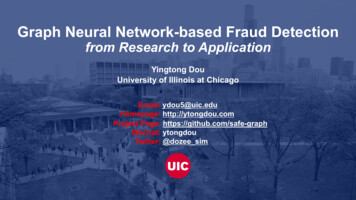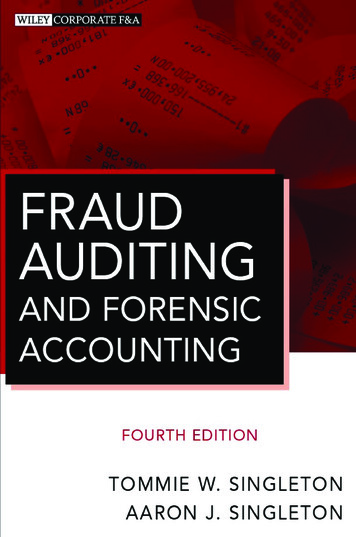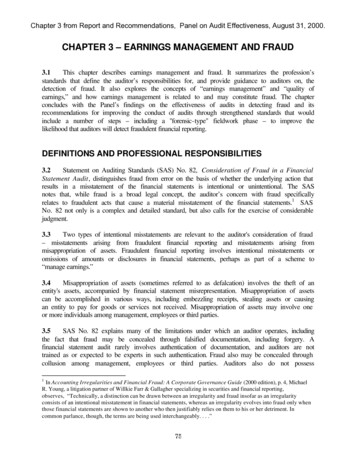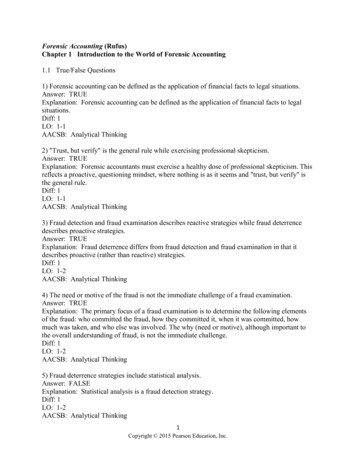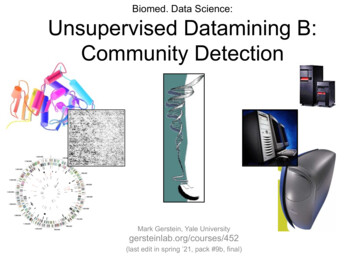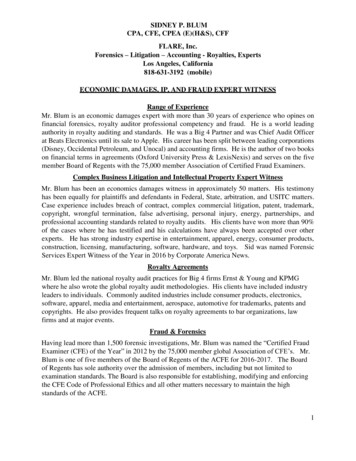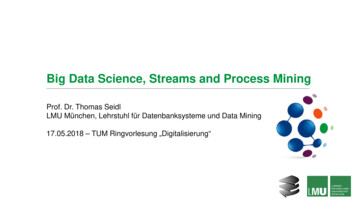
Transcription
Fraud Detection in Health Insurance Claims –A Machine Learning (ML) ApproachJune 25, 2021Claims Fraud Detection using XGBoostPritha DattaAssistant Vice PresidentManipalCigna Health Insurance Company
Fraud Detection in Health Insurance Claims: Bridging the GapComplications – The Gap / Trigger Incidence of frauds is significantly less than thetotal number of claims – class imbalance Ever evolving nature of fraudulent claims Costs of the two types of classification errors (FP*and FN*) are not the sameSituation – Current StateDesired Future State There are a variety of fraudpatterns: Fraud by healthcare providers Fraud by Insurance subscribers Conspiracy frauds or nexus ofproviders, customers anddistribution channels We are able to detect 100% of thefraudulent claims We are able to minimize theincorrect fraud classifications –i.e. minimize both FP* and FN* Rule-based and manual frauddetection approach results is a lot offalse investigationsQuestions – before we start Is there adequate data, i.e. data depth? Is the data clean and usable, i.e. data quality? Data system sophistication and preparedness*Note : FP – False Positive FN – False Negativewww.actuariesindia.org
Key Machine Learning Conceptswww.actuariesindia.org
Machine Learning vs. Rule-Based Systems in Fraud DetectionFigure 1 : Comparison of Rule-based and ML-based fraud detectionThere are two types of ML approaches that are commonly used – both independently or combined:-Supervised ML : training an algorithm on labeled historical data i.e. where you have an input (X) and output (Y) variable.Goal is to learn the mapping function from X to Y i.e. Y f(X), and use the same to predict the output variables of a newinput dataset- Supervised learning problems can be further grouped into regression and classification problems-Unsupervised ML : processing unlabeled data i.e. where you only have input data (X) and no corresponding outputvariables. Goal for unsupervised learning is to model the underlying structure or distribution in the data in order to learnmore about the data- Unsupervised learning problems can be further grouped into clustering and association problemswww.actuariesindia.org
Supervised Learning : Classification AlgorithmClaimAlgorithmGenuineFraudFigure 2 : Diagrammatic representation of a binary classification algorithmClassification predictive modeling is the task of approximating a mapping function from input variables to discreteoutput variables – Male or Female, True or False, Fraud or Genuine, etc.Types of Classification: Binary Classification: Classification task with two possible outcomes Multi-class classification: Classification with more than two classes Multi-label classification: Classification task where each sample is mapped to a set of target labelsTypes of Classification Algorithm: Logistic Regression Naïve Bayes classifier Support Vector machines K-nearest Neighbour Decision Treewww.actuariesindia.orgFigure 2*
Ensemble Learning : Aggregating Weak LearnersEnsemble learning is a machine learning method where multiple models (often called “weak learners”) aretrained to solve the same problem and combined to get better results.The main hypothesis is that when weak models are correctly combined we can obtain more accurateand/or robust models.Three major kinds of meta-algorithms that aims at combining weak learners:BaggingConsiders homogeneous weak learners, learns them independently in parallel and combinesthem following a deterministic averaging processBoostingConsiders homogeneous weak learners, learns them sequentially and combines them following adeterministic strategyStackingConsiders heterogeneous weak learners, learns them in parallel and combines them by training a meta-model to output aprediction based on the different weak models predictionswww.actuariesindia.org
Tree-Based Models : Decision Tree and Ensemble TreesTree-based models use a series of if-then rules to generatepredictions from one or more decision trees.Advantages: Straightforward interpretation Good at handling complex, non-linear relationshipsDisadvantages: Predictions tend to be weak, as singular decision treemodels are prone to overfitting Unstable, as a slight change in the input dataset cangreatly impact the final resultsFigure 3 : Visualizing a Decision TreeEnsemble algorithms that utilize decision trees as weak learners have multiple advantages:-Easy to understand and visualizeCan handle mixed data typesAccount for multi-collinearityBetter at handling outliers and noise-Non-parametric, no specific distributionCan handle unbalanced and large dataDo not tend to overfitComputationally inexpensivewww.actuariesindia.org
Case Study : Claims Fraud Detectionusing XGBoostwww.actuariesindia.org
Advanced Fraud Detection : How to Build a Robust System?Labeling DataIt is hard to manually classify new and sophisticated fraud attempts bytheir implicit similarities. It is thus essential to apply unsupervisedlearning models to segment data items into clusters to unearthhidden patterns such as a nexus between hospital and agents, certainfraud prone locations or just cleaning data and identifying outliers.Techniques : K-means clustering, Association Mining, Text MiningTraining Supervised ModelOnce the data is labeled, it captures not only the proven past fraud/nonfraud items, but also suspicious patterns and nexuses. The next step is touse the labeled dataset to train supervised models that will be usedto detect fraudulent transactions in the future.Techniques : Logistic Regression, Decision Tree, Random Forest,XGBoost – to name a few.Ensembling : To make predictions more accurate it is advisable to buildmultiple models using the same method or combine entirely differentmethods. It leverages the strengths of multiple different methods andprovides the most precise output.Figure 4 : Diagrammatic representation of an advancedfraud detection processwww.actuariesindia.org
Model Building and ComparisonStep 1 : Data PreparationTypes of data :Claims Data Policy Information Customer Demographics Provider Information Distribution ChannelInformationClaim Noclaim 34669claim 5894claim 23443claim 68392Fraud Disease SMember Gender Age Band FemaleFemaleFemaleMale0 - 1726-350 - 1726-35 Figure 5 : Excerpt from the data matrix for XGBoostData Cleaning & Standardization : includes outlier treatments, missing value treatments and approaches like text miningExploratory Data Analysis : to identify existing data patterns and anomaliesFeature Engineering : process of transforming raw data into features that better represent the underlying problem to thepredictive models, resulting in improved model performance on unseen dataStep 2 : Model Development Divide dataset into training data (70%) and test data (30%) in a statistically random mannerBased on the initial model performance, different features are engineered and re-testedIn order to improve model performance, the parameters that affect the performance are tweaked and re-testedIdentify the “best” algorithm using model diagnostics – XGBoost in this caseUse XGBoost algorithm to create a model to predict fraudulent claimswww.actuariesindia.org
Interpreting the Model : Output & Threshold SelectionModel Output-The model provides a measure of the certainty oruncertainty of a prediction – propensity score-This score is converted into a class label, governed by aparameter known as the decision threshold - 0.5 is thedefault for normalized predicted probabilities-Along with propensity scores, the model provides arelative importance matrix – containing the mostrelevant drivers for our modelFigure 6 : XGBoost Feature Importance Bar ChartThreshold Selection:For a binary classification problem with class labels 0 and 1: Prediction 0.5 Class 0 Prediction 0.5 Class 1Default threshold may not represent an optimal interpretation, due to: The class imbalance in data The cost of one type of misclassification is more than another type of misclassificationwww.actuariesindia.org
Interpreting the Model : Performance CriterionModel Performance Criterion:-ROC is a method of visualizing classification quality, which shows the dependency between TPR* andFPR* at different thresholds-For each threshold we obtain a (TPR, FPR) pair, which corresponds to one point on the ROC curveFigure 8 : Confusion MatrixFor each classification with one value of thethreshold we also have the correspondingConfusion MatrixFigure 7 : TPR vs FPR represented as ROC to determine AUC-AUC : The perfect model leads to AUC 1 (100% TPR and 0% FPR)-Gini Coefficient : GC 2 *AUC – 1 (the classifier’s advantage over a purely random one)GC 1 denotes a perfect classifier*Note : TPR – True Positive Rate TP / (TP FN) FPR – False Positive Rate FP / (FP TN)www.actuariesindia.org
Interpreting the Model : Optimal Threshold SelectionYouden’s J Statistic:-J Sensitivity* Specificity* – 1J TPR (1 – FPR) – 1 TPR – FPR-We can then choose the threshold with the largest J statistic valuePoints to note:-Optimal threshold does not necessarilyoptimize the accuracy-Accuracy is highly affected by class imbalance-The use of a single index is therefore notgenerally recommendedFigure 9 : ROC with optimal threshold-From a practical usage perspective, the threshold can be chosen based on a cost-benefit calculationThe benefit is the “saved” claim cost and the cost is the expenses incurred for investigation*Note : Sensitivity TPR Specificity 1- FPRwww.actuariesindia.org
Model Selection : Why was XGBoost Chosen?During model development phase multiple algorithms are tested. For our case study, the following weretested: Logistic regression – with ROSE and SMOTE (sampling techniques) Logistic regression does not support imbalanced classification directly. It requires heavy over/under sampling formodel convergence Accuracy of the model at a defined threshold was lesser the accuracy of the tree-based models Tree-based Model: Random Forest and XGBoost While both are ensemble decision trees, the two main differences are: How trees are built: Random Forest works on the principle of bagging while XGBoost works onboosting - with each “new” model correcting the errors of the previous one Combining results: Random Forest combines results at the end of the process (by averaging or"majority rules") while XGBoost combines results along the way Random Forest and XGBoost each excel in different areas Random forests perform well for multi-class object detection XGBoost performs well when you have unbalanced data For our case study the Random Forest Model was rejected due to overfittingFinal algorithm chosen was XGBoost – highest accuracy without overfittingwww.actuariesindia.org
Implementation : Dynamic, Real-time Fraud Detection-Once deployed, the model should be refreshed at a regular interval to incorporate the new fraud patterns-A robust feedback loop is extremely important for the success of any ML modelClaimXGBoost ModelGenuineFraudFeedbackInvestigationFinal OutcomeFigure 10 : Practical Implementation ApproachStarting up with XGBoostThere is a comprehensive guide on the XGBoost documentation website.It covers installation details, tutorials across different operating platforms and languageswww.actuariesindia.org
Key TakeawaysML models are trained to identifyalready established fraudpatterns- There will be a bias towardsexisting fraud patterns-Needs to be revisited at regularintervals, during the initialphase, to evaluate and tune themodelSuccess of the model depends onthe variety of data available (datadepth), the usability of the availabledata and a robust feedback loop-Predictive quality dependsmore on data than onalgorithm- There is no single BESTalgorithm- Performance varies onthe type of data one isworking with-Outperformance byEnsemble Classifiers :aggregation of weak classifierscan out-perform predictionsfrom a single strong performerwww.actuariesindia.org
References XGBoost Documentation - l Decision Tree Classification in Python - ion-tree-classificationpython Feature Importance and Feature Selection With XGBoost in Python - ce-and-feature-selection-with-xgboost-in-python/ A Gentle Introduction to Threshold-Moving for Imbalanced Classification g-for-imbalanced-classification/ Youden's J statistic - https://en.wikipedia.org/wiki/Youden%27s J statistic Fraud Detection: How Machine Learning Systems Help Reveal Scams in Fintech, Healthcare, and eCommerce,by altexsoft Figure 8 - Comparative Analysis of Machine Learning Techniques for Detecting Insurance Claims Fraud - actuariesindia.org
www.actuariesindia.org Machine Learning vs. Rule-Based Systems in Fraud Detection There are two types of ML approachesthat are commonly used -both independently or combined:-Supervised ML : training an algorithm on labeled historical data i.e. where you have an input (X) and output (Y) variable.Goal is to learn the mapping function from X to Y i.e. Y f(X), and use the same to predict the .
